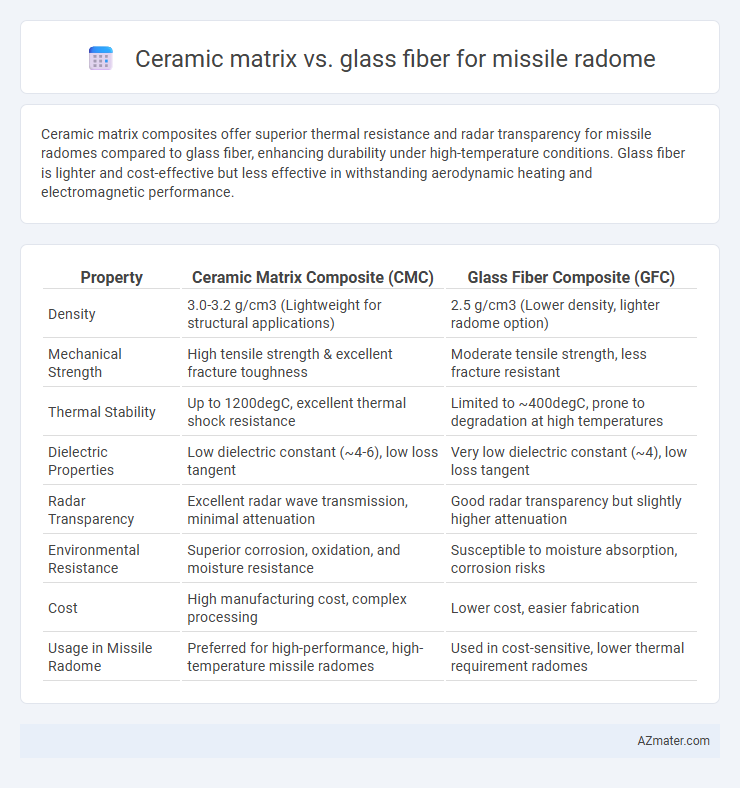Ceramic matrix composites offer superior thermal resistance and radar transparency for missile radomes compared to glass fiber, enhancing durability under high-temperature conditions. Glass fiber is lighter and cost-effective but less effective in withstanding aerodynamic heating and electromagnetic performance.
Table of Comparison
| Property | Ceramic Matrix Composite (CMC) | Glass Fiber Composite (GFC) |
|---|---|---|
| Density | 3.0-3.2 g/cm3 (Lightweight for structural applications) | 2.5 g/cm3 (Lower density, lighter radome option) |
| Mechanical Strength | High tensile strength & excellent fracture toughness | Moderate tensile strength, less fracture resistant |
| Thermal Stability | Up to 1200degC, excellent thermal shock resistance | Limited to ~400degC, prone to degradation at high temperatures |
| Dielectric Properties | Low dielectric constant (~4-6), low loss tangent | Very low dielectric constant (~4), low loss tangent |
| Radar Transparency | Excellent radar wave transmission, minimal attenuation | Good radar transparency but slightly higher attenuation |
| Environmental Resistance | Superior corrosion, oxidation, and moisture resistance | Susceptible to moisture absorption, corrosion risks |
| Cost | High manufacturing cost, complex processing | Lower cost, easier fabrication |
| Usage in Missile Radome | Preferred for high-performance, high-temperature missile radomes | Used in cost-sensitive, lower thermal requirement radomes |
Introduction to Missile Radome Materials
Missile radomes require materials with low dielectric constants and high thermal stability to ensure signal transmission integrity under extreme conditions. Ceramic matrix composites offer superior thermal resistance, mechanical strength, and durability compared to traditional glass fiber composites, making them ideal for high-speed missile applications. Glass fiber materials provide cost-effective solutions with good dielectric properties but generally lack the heat resistance and structural robustness necessary for advanced missile radomes.
Importance of Radome Material Selection
Ceramic matrix composites offer superior thermal resistance and mechanical strength, crucial for missile radomes exposed to high-speed aerodynamic heating and impact. Glass fiber materials provide lightweight and cost-effective solutions but exhibit lower thermal stability and radar transparency compared to ceramics. Selecting a radome material with optimal electromagnetic wave transmission, structural integrity, and thermal endurance directly impacts missile guidance accuracy and survivability under extreme operational conditions.
Overview of Ceramic Matrix Composites
Ceramic Matrix Composites (CMCs) offer superior thermal stability, high strength-to-weight ratios, and exceptional resistance to high-velocity impacts, making them ideal for missile radome applications where durability under extreme conditions is critical. Unlike Glass Fiber Reinforced Polymers (GFRP), CMCs withstand temperatures exceeding 1200degC without significant degradation, ensuring signal integrity and structural integrity in hypersonic environments. Their low dielectric constant and tailored anisotropic properties enable enhanced electromagnetic transparency crucial for radar performance in advanced missile systems.
Overview of Glass Fiber Composites
Glass fiber composites offer lightweight, high-strength properties critical for missile radome applications, combining excellent corrosion resistance with cost-effective manufacturing processes. Their dielectric properties ensure minimal signal attenuation and high radar transparency, maintaining missile guidance and communication integrity. Glass fiber composites also provide superior impact resistance and thermal stability under varying operational environments, making them a reliable choice for radome structural components.
Electromagnetic Transparency: Ceramic Matrix vs Glass Fiber
Ceramic matrix composites exhibit superior electromagnetic transparency compared to glass fiber materials, making them ideal for missile radome applications that require minimal signal attenuation and distortion. The low dielectric constant and loss tangent of ceramic matrices enable better RF signal transmission at various radar frequencies, enhancing detection and guidance system performance. In contrast, glass fiber composites often possess higher dielectric losses, leading to reduced electromagnetic transparency and potential signal degradation under high-frequency radar exposure.
Thermal Resistance and High-Temperature Performance
Ceramic matrix composites exhibit superior thermal resistance and high-temperature performance compared to glass fiber materials, making them ideal for missile radomes operating in extreme thermal environments. Their ability to maintain structural integrity and dielectric properties at temperatures exceeding 1000degC surpasses the limitations of glass fiber, which typically degrades above 500degC. Enhanced thermal shock resistance and oxidation stability of ceramic matrices ensure reliable radar signal transmission and protection during high-speed flight and re-entry conditions.
Mechanical Strength and Structural Integrity
Ceramic matrix composites exhibit superior mechanical strength and thermal stability compared to glass fiber, making them ideal for missile radomes subjected to extreme aerodynamic and thermal stresses. Their inherent high fracture toughness and resistance to crack propagation ensure enhanced structural integrity under high-velocity impact and temperature fluctuations. Glass fiber, while lightweight and cost-effective, typically offers lower tensile strength and diminished durability, limiting its application in demanding missile radome environments.
Environmental Durability and Weathering
Ceramic matrix composites exhibit superior environmental durability compared to glass fiber in missile radomes due to their resistance to high temperatures, moisture, and UV radiation. They maintain structural integrity and electromagnetic transparency under severe weathering conditions, including thermal cycling and salt fog exposure. Glass fiber, while lighter, tends to degrade faster from prolonged environmental stress, limiting its lifespan in harsh operational environments.
Cost Considerations and Manufacturing Complexity
Ceramic matrix composites for missile radomes offer superior thermal resistance and mechanical strength but entail higher manufacturing complexity and costs due to advanced processing techniques and raw material expenses. Glass fiber composites provide a cost-effective alternative with simpler fabrication and lower material costs, though they deliver comparatively lower thermal stability and impact resistance. Cost considerations must balance the mission-specific performance requirements with production scalability and lifecycle expenses.
Conclusion: Choosing the Optimal Radome Material
Ceramic matrix composites exhibit superior thermal resistance and structural integrity for missile radomes operating in extreme environments, ensuring reliable signal transmission and durability. Glass fiber composites offer cost-effective manufacturing and lighter weight but may sacrifice performance under high thermal or mechanical stress conditions. Selecting the optimal radome material hinges on mission requirements, balancing thermal stability, radar transparency, mechanical strength, and overall system weight.

Infographic: Ceramic matrix vs Glass fiber for Missile radome
 azmater.com
azmater.com